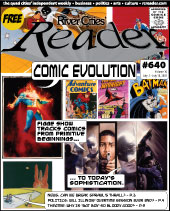One of the biggest success stories to come out of Bucktown Center for the Arts is Emily Christenson and her nature-inspired works. Some early visitors to doeGallery were impressed with her art and took a postcard of one of her paintings back to a favorite gallery in Washington, DC. Within a year, Christenson's work was hanging on the walls at the Fine Art & Artists (FAA) Gallery in Georgetown along with some of the big names of the 20th Century. Luck certainly played a role in Christenson's story, but if the work hadn't been so good and so captivating, it wouldn't have gone any further than being a souvenir postcard.
At FAA, Christenson enjoyed two years of strong sales, a solo show of her work, and a review in the Washington Post. She was preparing a body of work for her second solo show, Rivers & Rain, Pieces of Denali, when she got a call that the gallery was closing after 15 years.
More than a year later, Christenson is premiering both a new Bucktown gallery/studio (called "e|c") and the 10 works that make up Rivers & Rain, Pieces of Denali. The show runs through the end of December, and the gallery is in the southeast corner on the second floor.

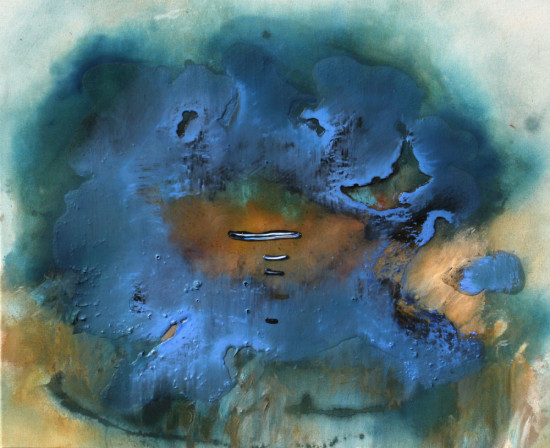
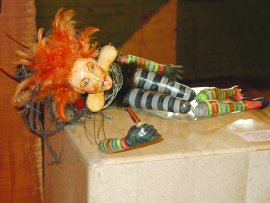 A small woman with clenched fists full of feathers plucked from her own legs is watched by smiling, colorful faces reminiscent of the simplistic advertising from the faux utopia of the 1950s. This is a microcosm of a room full of sculptures and paintings that present themselves with a straightforward charm that makes you smile, and then you realize there are darker themes that temper the smile with unease.
A small woman with clenched fists full of feathers plucked from her own legs is watched by smiling, colorful faces reminiscent of the simplistic advertising from the faux utopia of the 1950s. This is a microcosm of a room full of sculptures and paintings that present themselves with a straightforward charm that makes you smile, and then you realize there are darker themes that temper the smile with unease.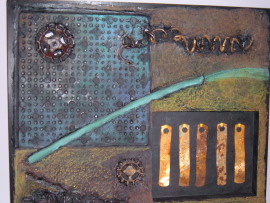 Pressed clumps of richly textured paper pulp shaped into crusty grates, inquisitive fish, and smooth vertebrae are given chromatic life with hints of vibrant blue-greens, rusty reds, and creamy whites. These colors and textures are given room to breathe with large expanses of grays and earth tones.
Pressed clumps of richly textured paper pulp shaped into crusty grates, inquisitive fish, and smooth vertebrae are given chromatic life with hints of vibrant blue-greens, rusty reds, and creamy whites. These colors and textures are given room to breathe with large expanses of grays and earth tones.
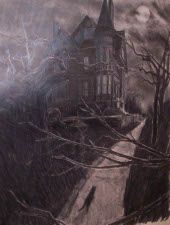 Creepy bunny costumes rendered in charcoal on paper, elongated hands rising out of the water to scratch at the stormy sky, a long, unspooled, film-like reel of hands signing out a missive wrapped around toppled driftwood pillars, and a possible gate to the underworld are parts of two separate book-based bodies of work now at Quad City Arts. One set re-presents the familiar with superb technical eloquence, utilizing the book as an end-product receptacle. The other, more adventurous body of work requires the book to become a component of the viewer's experience of the show.
Creepy bunny costumes rendered in charcoal on paper, elongated hands rising out of the water to scratch at the stormy sky, a long, unspooled, film-like reel of hands signing out a missive wrapped around toppled driftwood pillars, and a possible gate to the underworld are parts of two separate book-based bodies of work now at Quad City Arts. One set re-presents the familiar with superb technical eloquence, utilizing the book as an end-product receptacle. The other, more adventurous body of work requires the book to become a component of the viewer's experience of the show.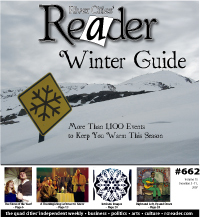
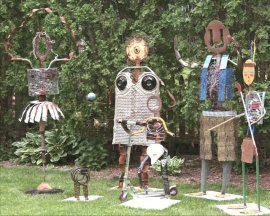 The use of found objects carries an up-front challenge to artists. Do you try to transform the identity of the "junk" by visually turning it into something else? Or do you accept the object (and all of its cultural baggage) for what it is and shape your artistic statement to incorporate the materials and their recognizability?
The use of found objects carries an up-front challenge to artists. Do you try to transform the identity of the "junk" by visually turning it into something else? Or do you accept the object (and all of its cultural baggage) for what it is and shape your artistic statement to incorporate the materials and their recognizability?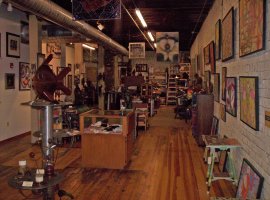 When it comes to art, most artists will tell you that the excitement, or the magic, actually happens during the creative process. And that usually happens in the studio.
When it comes to art, most artists will tell you that the excitement, or the magic, actually happens during the creative process. And that usually happens in the studio.